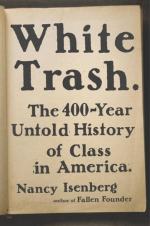|
This section contains 656 words (approx. 2 pages at 400 words per page) |

|
The American Dream
Isenberg alludes to the notion of the American Dream throughout her study. The concept was invented over time by intellectuals and politicians who sought to defend America’s reputation on the global stage. A nation founded on the concept of waste people needed obvious defending. Many of America’s most renowned historical figures created the American Dream with knowingly false claims to economic equality, a class-free society, and immeasurable opportunity.
Waste Pepole
Waste People is one of the first terms Isenberg uses to address the subject of her study, poor rural whites. The concept dates to colonization, when waste people were needed to fertilize the wasteland of the colonies with their labor. Isenberg contests all societies have their waste people, but they all fall under different names. The deeply ingrained English contempt for waste was prevalent in the colonies’ treatment of their waste people.
The South
|
This section contains 656 words (approx. 2 pages at 400 words per page) |

|




